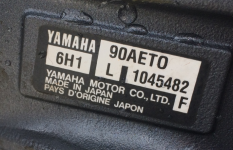FloatingBy
Cadet
- Joined
- Aug 13, 2023
- Messages
- 10
Hi all, I've seen a few other threads about this which didn't quite match my scenario so I thought I'd post my own in the hope of some diagnostic suggestions.
I have a 2010 Yamaha 90A (AETO). It has no spark. Was running perfectly and just shut down, wouldn't restart. I am no boat engineer but have some tools and service manual (not all of which makes sense to me, being honest!).
I have seen advice about cleaning 'contacts' under flywheel. But from what I have been told, the only 'contacts' under there are not contacts, just magnetic pick ups, and sealed in a resin casing so dirt/oil shouldn't prevent them functioning.
The only import detail is that we found a broken earth, one coming from the communal earth on the wiring cradle. We replaced the wire (corroded) with a good new circle connector so that's fixed. I hoped that would be the cure, but it wasn't, still no spark after doing that.
One very weird detail - We disconnected the crank sensor, put meter probes into the sensor male pins just to see what voltage was doing when cranking engine. It not just sparked but fired into life! As if that isn't weird enough (I wouldn't think it can run without crank sensor connected to CDI), we plugged it back in and it fired up again!
Then today there's no spark again. All plugs are good and clean, and battery is very good.
Any suggestions would be appreciated at this point, as can't afford to take it to the dealer right now, and kids have fish to catch
thanks for any ideas
I have a 2010 Yamaha 90A (AETO). It has no spark. Was running perfectly and just shut down, wouldn't restart. I am no boat engineer but have some tools and service manual (not all of which makes sense to me, being honest!).
I have seen advice about cleaning 'contacts' under flywheel. But from what I have been told, the only 'contacts' under there are not contacts, just magnetic pick ups, and sealed in a resin casing so dirt/oil shouldn't prevent them functioning.
The only import detail is that we found a broken earth, one coming from the communal earth on the wiring cradle. We replaced the wire (corroded) with a good new circle connector so that's fixed. I hoped that would be the cure, but it wasn't, still no spark after doing that.
One very weird detail - We disconnected the crank sensor, put meter probes into the sensor male pins just to see what voltage was doing when cranking engine. It not just sparked but fired into life! As if that isn't weird enough (I wouldn't think it can run without crank sensor connected to CDI), we plugged it back in and it fired up again!
Then today there's no spark again. All plugs are good and clean, and battery is very good.
Any suggestions would be appreciated at this point, as can't afford to take it to the dealer right now, and kids have fish to catch
thanks for any ideas




















